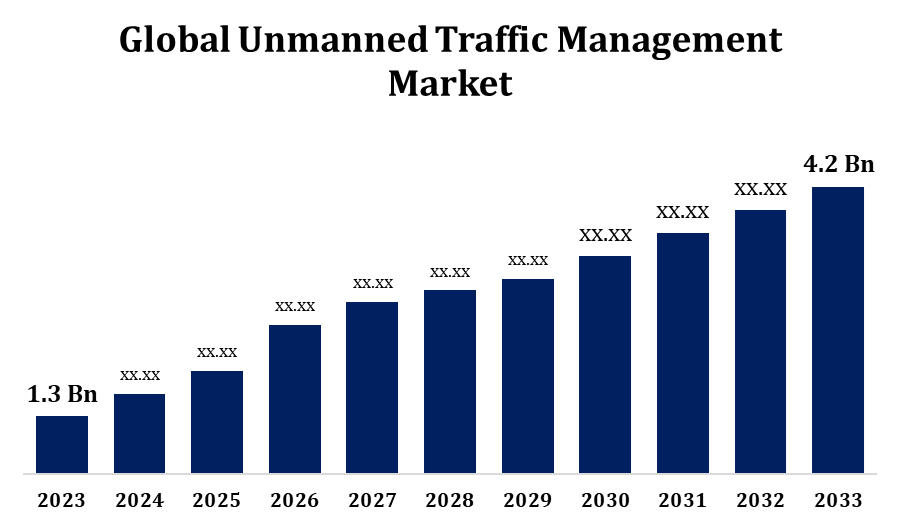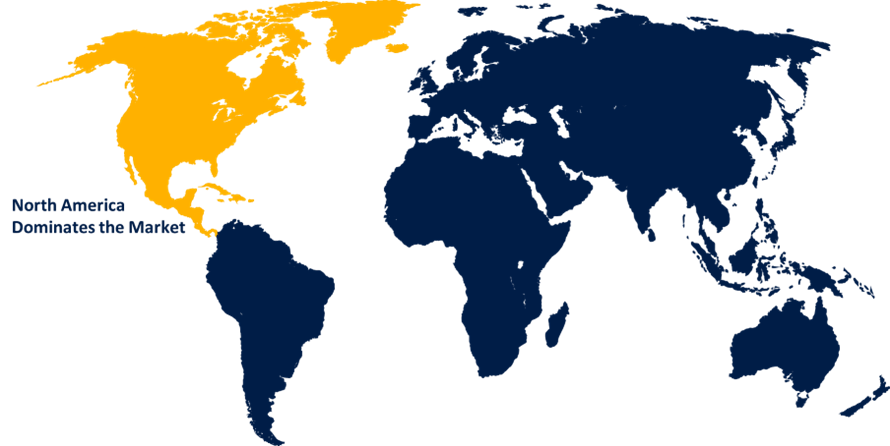Global Unmanned Traffic Management Market Size, Share, and COVID-19 Impact Analysis, By Component (Hardware, Software), By End Use (Commercial, Military & Government), By Application (Commercial Aviation, Homeland Security, Logistics and Transportation, Others), and By Region (North America, Europe, Asia-Pacific, Latin America, Middle East, and Africa), Analysis and Forecast 2023 - 2033
Industry: Aerospace & DefenseGlobal Unmanned Traffic Management Market Insights Forecasts to 2033
- The Unmanned Traffic Management Market was valued at USD 1.3 billion in 2023.
- The market is growing at a CAGR of 12.44% from 2023 to 2033.
- The global Unmanned Traffic Management Market is expected to reach USD 4.2 billion by 2033.
- Asia Pacific is expected to grow the fastest during the forecast period.

Get more details on this report -
The global Unmanned Traffic Management Market is expected to reach USD 4.2 billion by 2033, at a CAGR of 12.44% during the forecast period 2023 to 2033.
The Unmanned Traffic Management market is evolving rapidly, driven by the increasing adoption of autonomous vehicles and drones. Unmanned Traffic Management market analysis indicates significant growth due to the rising demand for efficient airspace management solutions. As the market expands, the Unmanned Traffic Management system market size is expected to witness substantial increases, propelled by advancements in drone technology and urban air mobility. Key factors such as safety regulations, infrastructure development, and airspace integration are influencing market trends. The Unmanned Traffic Management market segmentation includes solutions tailored to various sectors, including government, logistics, and commercial services. This segmentation is vital for addressing specific needs in air traffic control and ensuring seamless UAV operations within controlled airspace, paving the way for future aerial mobility systems.
Unmanned Traffic Management Market Value Chain Analysis
The Unmanned Traffic Management market value chain analysis highlights key stages involved in the development and deployment of unmanned traffic systems. The process begins with research and development, where advancements in drone technology, airspace management solutions, and regulatory frameworks are crucial. Following this, manufacturers produce hardware, including drones, communication systems, and sensors. These components are then integrated into comprehensive Unmanned Traffic Management systems. The next stage involves service providers offering installation, monitoring, and maintenance services to ensure smooth operations. Finally, end-users, such as government agencies, logistics companies, and other industries, implement these solutions for effective airspace management and drone operations. Collaboration across all stakeholders, including regulators and technology developers, is essential to create a robust and efficient value chain for the Unmanned Traffic Management market.
Unmanned Traffic Management Market Opportunity Analysis
The Unmanned Traffic Management market offers significant opportunities, driven by the growing demand for drones and autonomous vehicles. With the rapid development of urban air mobility, there is an increasing need for advanced airspace management solutions to ensure safe and efficient UAV operations. This presents opportunities for technology providers to innovate in areas like real-time air traffic control, communication systems, and collision avoidance. Additionally, regulatory advancements and government support are opening doors for the commercialization of unmanned traffic management systems across various sectors, including logistics, agriculture, and emergency services. The market also sees potential in the integration of artificial intelligence and machine learning for improved decision-making and automation. As infrastructure and safety measures evolve, the Unmanned Traffic Management market is poised for substantial growth, offering diverse opportunities for investment and development.
Global Unmanned Traffic Management Market Report Coverage
| Report Coverage | Details |
|---|---|
| Base Year: | 2023 |
| Market Size in 2023: | USD 1.3 billion |
| Forecast Period: | 2023 – 2033 |
| Forecast Period CAGR 2023 – 2033 : | 12.44% |
| 023 – 2033 Value Projection: | USD 4.2 billion |
| Historical Data for: | 2019 - 2022 |
| No. of Pages: | 210 |
| Tables, Charts & Figures: | 115 |
| Segments covered: | By End Use, By Application and COVID-19 Impact Analysis |
| Companies covered:: | Leonardo S.p.A., Thales Group, L3Harris Technologies, Inc., Lockheed Martin Corporation, Airbus SE, Unifly NV, Frequentis AG, AirMap, Inc., OneSky Systems, RTX Corporation, and other key players |
| Pitfalls & Challenges: | Covid-19 Empact, Challenges, Growth, Analysis. |
Get more details on this report -
Market Dynamics
Unmanned Traffic Management Market Dynamics
The increasing demand for air logistics services is expected to drive the growth of drone usage
The increasing demand for air logistics services is expected to drive significant growth in the Unmanned Traffic Management market. As e-commerce and supply chain sectors expand, the need for efficient, fast, and cost-effective delivery solutions intensifies. Drones are becoming essential in addressing these needs, offering faster last-mile delivery and reducing operational costs. This growing reliance on drones for air logistics is fueling the demand for advanced Unmanned Traffic Management systems to ensure safe and efficient airspace management. As drones become more prevalent in the logistics industry, managing air traffic effectively will be critical to avoiding collisions and congestion. Consequently, the Unmanned Traffic Management market is poised to grow, with increased investments in infrastructure, regulations, and technologies to accommodate the rising use of drones in commercial logistics operations.
Restraints & Challenges
One major hurdle is the complex regulatory environment, with varying airspace rules and safety standards across regions. The lack of universal regulations for drone operations poses challenges in creating a standardized approach to Unmanned Traffic Management. Additionally, integrating drones into existing airspace, which is already crowded with manned aircraft, presents operational difficulties in terms of coordination and conflict resolution. Technical issues such as ensuring reliable communication systems, real-time data processing, and robust collision avoidance technology are also critical challenges. Furthermore, the high costs of implementing UTM systems and the lack of infrastructure in certain areas can hinder market adoption. Addressing these challenges is essential for ensuring the safe and efficient operation of drones within the global airspace.
Regional Forecasts
North America Market Statistics

Get more details on this report -
North America is anticipated to dominate the Unmanned Traffic Management Market from 2023 to 2033. The U.S. is a key player, with the Federal Aviation Administration (FAA) actively working on integrating drones into the national airspace, establishing clear guidelines for drone operations. North America’s strong e-commerce and logistics sectors also fuel the need for efficient air delivery solutions, driving drone adoption. Additionally, significant investments in research and development, along with collaborations between government agencies, drone manufacturers, and technology providers, are further accelerating market growth. As urban air mobility gains traction, North America is expected to remain a leading region for the development and deployment of Unmanned Traffic Management systems, ensuring safe and effective integration of drones into existing airspace.
Asia Pacific Market Statistics
Asia Pacific is witnessing the fastest market growth between 2023 to 2033. China, Japan, and India are investing heavily in drone technology and urban air mobility, creating a need for robust Unmanned Traffic Management systems. Governments in the region are developing regulations to ensure safe integration of drones into national airspace, fostering innovation and providing a conducive environment for market expansion. Additionally, the growth of e-commerce and the demand for faster, cost-effective delivery solutions further boost the need for drone-based services. As the region continues to embrace new technologies, the Unmanned Traffic Management market in Asia Pacific is poised for substantial growth, with investments in infrastructure and technology set to rise.
Segmentation Analysis
Insights by Component
The software segment accounted for the largest market share over the forecast period 2023 to 2033. Software plays a crucial role in enabling real-time data processing, flight monitoring, collision avoidance, and communication between unmanned aerial vehicles (UAVs) and ground control stations. As drone operations become more widespread, the demand for sophisticated software platforms that can integrate various UAVs into controlled airspace is on the rise. These software solutions help in ensuring safety, compliance with regulations, and efficient air traffic management. Additionally, the growth of urban air mobility and advancements in artificial intelligence and machine learning are further accelerating the development of software solutions that enhance automation and decision-making in the Unmanned Traffic Management market. This segment is expected to continue expanding as the use of drones increases globally.
Insights by Application
The commercial aviation segment accounted for the largest market share over the forecast period 2023 to 2033. With the rise of urban air mobility and the increasing use of drones in logistics, surveillance, and inspection, the need for efficient airspace management has grown, prompting advancements in Unmanned Traffic Management systems. These systems are designed to ensure the safe coexistence of commercial aircraft and drones within shared airspace. As governments and regulatory bodies develop and refine drone regulations, commercial aviation companies are investing in UTM solutions to manage drone traffic effectively. Additionally, the commercial aviation sector is exploring new business models involving drones, further driving the demand for UTM technologies to ensure safe, coordinated operations in both manned and unmanned air traffic environments.
Insights by End Use
The commercial segment accounted for the largest market share over the forecast period 2023 to 2033. As companies look for cost-effective and efficient solutions, drones offer significant advantages for last-mile delivery, asset monitoring, and aerial inspections. The demand for Unmanned Traffic Management systems is rising as commercial drone operations scale up, requiring advanced systems for safe navigation, collision avoidance, and airspace integration. The commercial sector also benefits from regulatory developments and growing infrastructure to support drone operations. With more businesses leveraging drones for commercial applications, UTM systems are becoming essential for managing drone fleets and ensuring compliance with air traffic safety standards. As this market segment expands, investments in UTM technologies are expected to grow, enabling seamless integration of commercial drones into existing airspace.
Recent Market Developments
- In April 2024, Terra Drone Corporation, a Japan-based provider of drone and Advanced Air Mobility (AAM) technology, has unveiled plans for collaborative development with its group entities, Aloft Technologies Inc. and Unifly NV.
Competitive Landscape
Major players in the market
- Leonardo S.p.A.
- Thales Group
- L3Harris Technologies, Inc.
- Lockheed Martin Corporation
- Airbus SE
- Unifly NV
- Frequentis AG
- AirMap, Inc.
- OneSky Systems
- RTX Corporation
Market Segmentation
This study forecasts revenue at global, regional, and country levels from 2023 to 2033.
Unmanned Traffic Management Market, Component Analysis
- Hardware
- Software
Unmanned Traffic Management Market, Application Analysis
- Commercial Aviation
- Homeland Security
- Logistics and Transportation
- Others
Unmanned Traffic Management Market, End Use Analysis
- Commercial
- Military & Government
Unmanned Traffic Management Market, Regional Analysis
- North America
- US
- Canada
- Mexico
- Europe
- Germany
- Uk
- France
- Italy
- Spain
- Russia
- Rest of Europe
- Asia Pacific
- China
- Japan
- India
- South Korea
- Australia
- Rest of Asia Pacific
- South America
- Brazil
- Argentina
- Rest of South America
- Middle East & Africa
- UAE
- Saudi Arabia
- Qatar
- South Africa
- Rest of the Middle East & Africa
Frequently Asked Questions (FAQ)
-
1. What is the market size of the Unmanned Traffic Management Market?The global Unmanned Traffic Management Market is expected to grow from USD 1.3 billion in 2023 to USD 4.2 billion by 2033, at a CAGR of 12.44% during the forecast period 2023-2033.
-
2. Who are the key market players of the Unmanned Traffic Management Market?Some of the key market players of the market are Leonardo S.p.A., Thales Group, L3Harris Technologies, Inc., Lockheed Martin Corporation, Airbus SE, Unifly NV, Frequentis AG, AirMap, Inc., OneSky Systems, RTX Corporation.
-
3. Which segment holds the largest market share?The commercial segment holds the largest market share and is going to continue its dominance.
-
4. Which region dominates the Unmanned Traffic Management Market?North America dominates the Unmanned Traffic Management Market and has the highest market share.
Need help to buy this report?